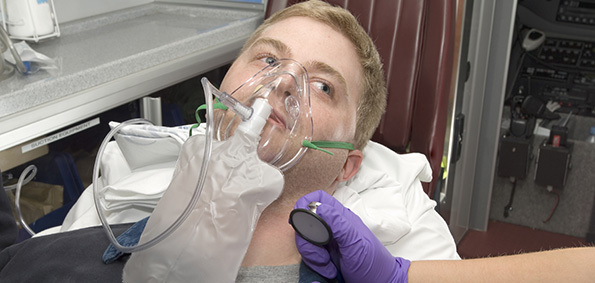CPR, AED, AND FIRST AID TRAINING
Emergency Use of Medical Oxygen 101
Why Do We Need Emergency Oxygen?
The air a person normally breathes contains approximately 21% oxygen. The concentration of oxygen delivered to a victim through rescue breathing is 16%. A condition known as hypoxia (insufficient oxygen to the body) can occur if a person goes without adequate oxygen for an extended period.

When Should Emergency Oxygen Be Used?
You should provide medical oxygen to a victim having difficulty breathing if it is available and if you are trained to administer oxygen. Medical oxygen should be considered if the person is showing signs and symptoms of hypoxia or if a pulse oximeter reading is 94% or lower.
Never delay appropriate care for life-threatening conditions, such as CPR, AED, or control of severe bleeding to get, set up, or administer medical oxygen in an emergency.
Signs and Symptoms of Hypoxia
Never withhold medical oxygen in an emergency when a person has signs and symptoms of hypoxia, with or without a pulse oximeter.
Mild Hypoxia
- SpO2 reading of 91%-94%
- Anxiety, confusion, restlessness
Moderate Hypoxia
- SpO2 reading of 86%-90%
- Rapid breathing
- Flaring of nostrils or pursed lips
- Rapid or slow heartbeat
- Shortness of breath
- Coughing
- Wheezing
- When breathing in, the person’s skin may suck in around and between the ribs or above the breastbone.
- The person may lean over by resting arms on their legs to increase lung expansion.
- The person may be unable to speak in full sentences or may need to catch their breath between sentences.
Severe Hypoxia
- SpO2 reading of 85% or less
- Changes in skin appearance and condition, such as sweaty, cool skin, and blue-tinged nail beds and lips.
- In people with darker skin pigmentation, the blue tinge may be more noticeable in the tissue that lines the inside of the eyelids and lips.
- The person may have an altered mental status or become unresponsive.
Tools for Emergency Oxygen
Oxygen Units

Oxygen Training Supplies

Personal Protective Equipment

Who Needs Emergency Oxygen Training?
The audience for Emergency Use of Medical Oxygen training is as varied as the audience for First Aid, CPR and AED training. Some of the common job titles who need training include:
- Emergency Response Providers - First Responders, EMRs, EMTs, Paramedics, Firefighters, Correction/Public Law Enforcement, Nurses and Doctors, Lifeguards, Ski Patrol, Public Safety Responders
- Employees with a Duty to Respond - Athletic Trainers, Flight Attendants, Hotel Hospitality, Security
- Employees in Hazardous Environments - Divers, High Altitude Locations, Mines
- Industrial/Corporate Emergency Response Team
- Any Company with Oxygen Cylinders Onsite
Take an Emergency Oxygen Administration Class
HSI's Emergency Use of Medical Oxygen program is ideal for lay and professional rescuers and teaches how to administer oxygen during an emergency.
The administration of oxygen during an emergency may delay damage to vital organs. A student will learn:
- When to use emergency oxygen and how it may help
- Set up and delivery with various delivery devices
- How to use oxygen during bag mask ventilation
- The risks associated with use and storage
- Safe storage and handling
- How to use oxygen with advanced equipment
